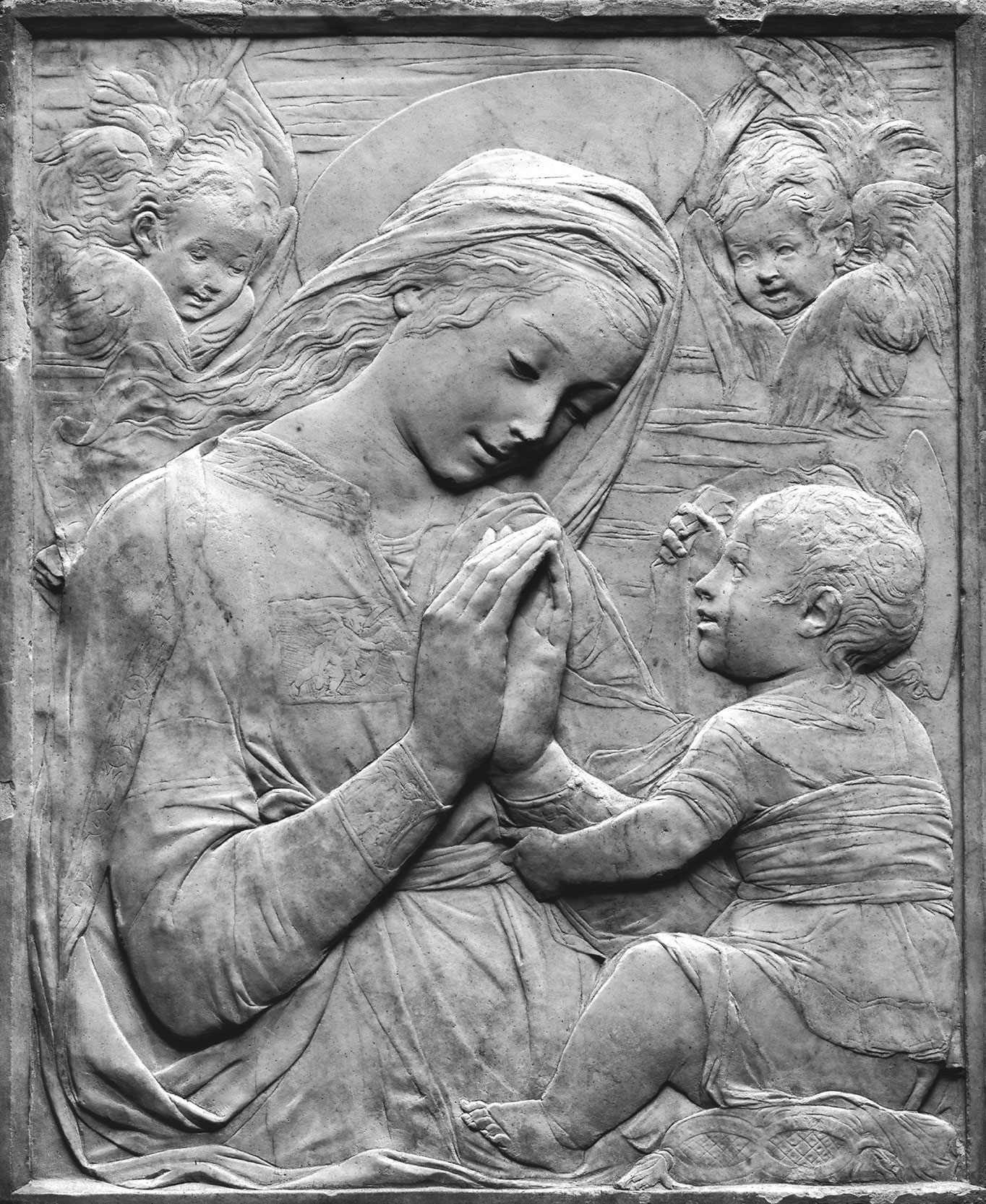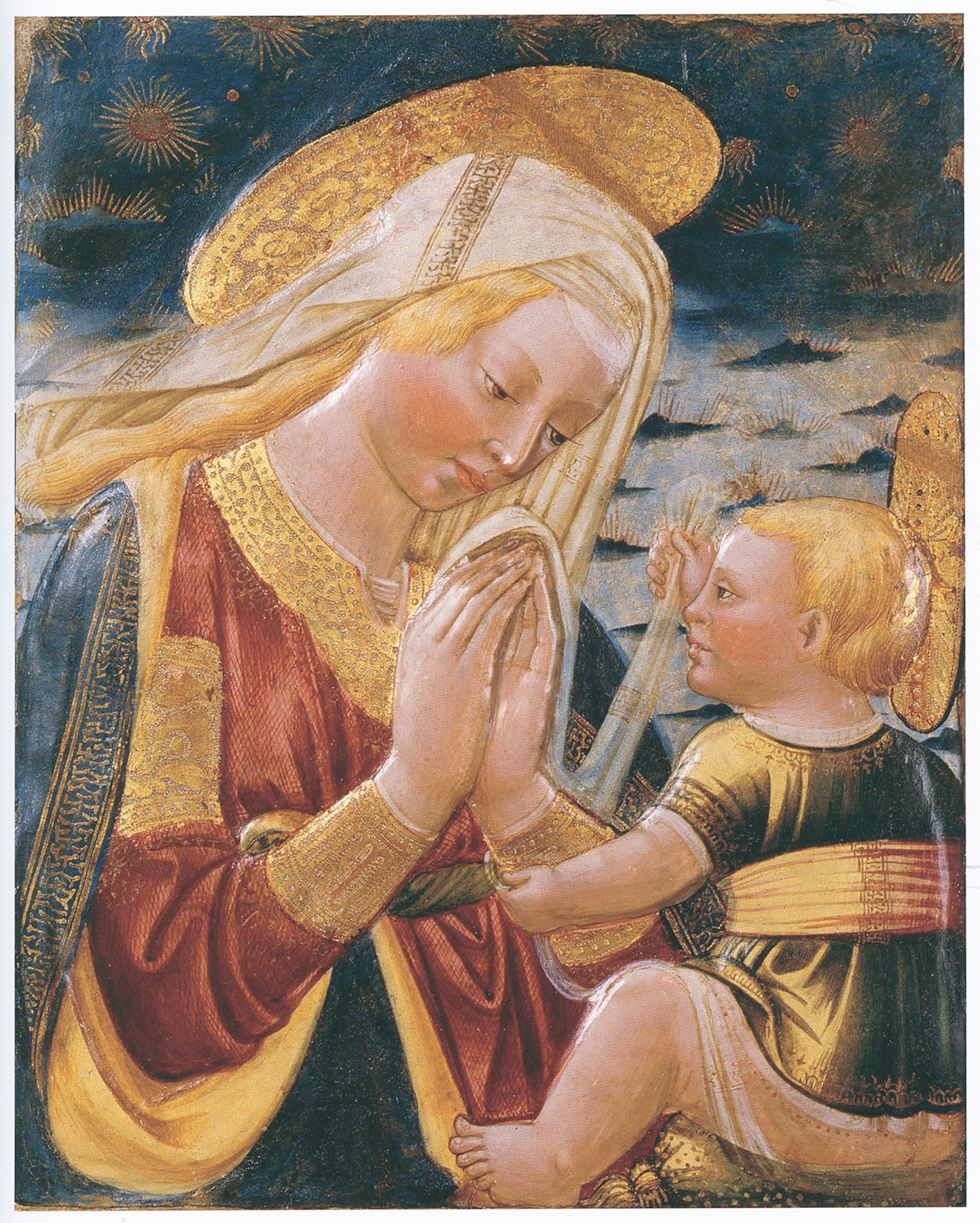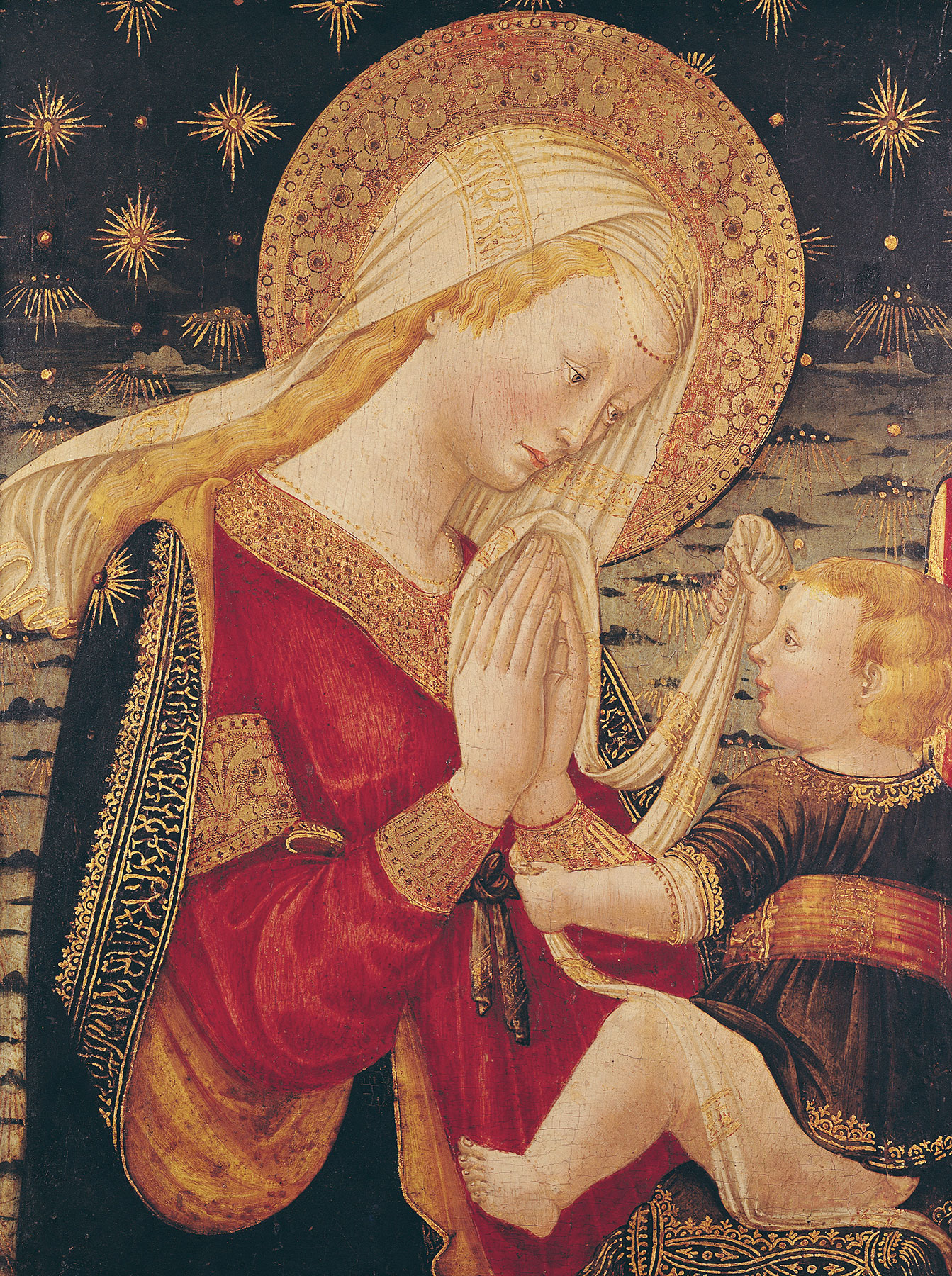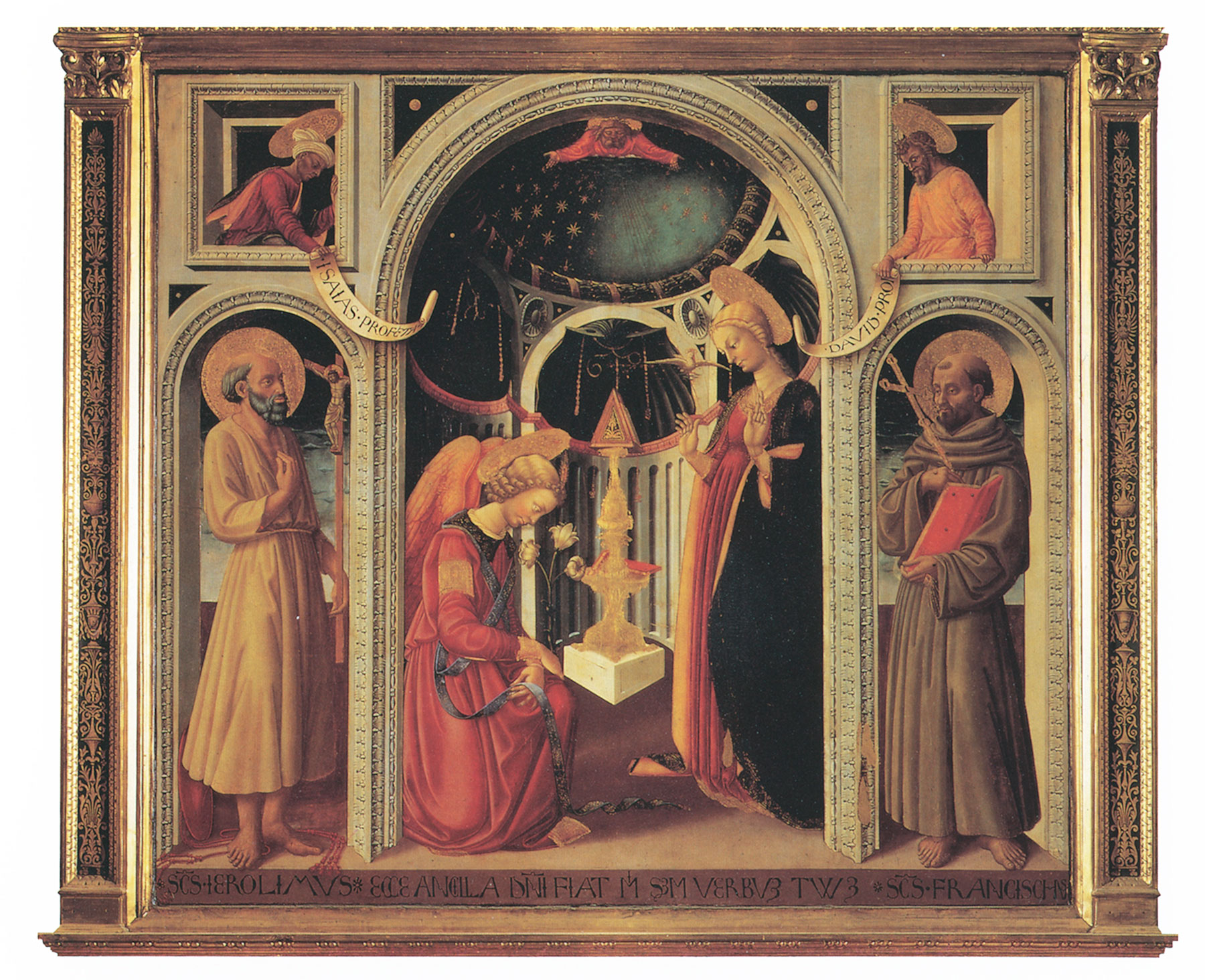Edward Hutton (1875–1969), London; Maitland Fuller Griggs (1872–1943), New York, by 1924
The panel, of a vertical wood grain, is 1.5 centimeters thick and has not been cradled. A barb along the left, bottom, and right edges of the paint surface indicates that these are intact as originally designed, although the composition has been cropped within the picture field at the top. A partial split, 10 centimeters long, extends down from the top edge of the panel, 11 centimeters from the right edge. The ultramarine-blue pigment originally comprising the upper section of the sky and the Virgin’s outer robe was scraped away at an unknown date: a 1961–62 cleaning by Andrew Petryn left these areas as exposed gesso (the sky was described by Charles Seymour, Jr., as “somewhat rubbed”).1 The green pigment of the festooned garland at the top and sides of the image has oxidized to brown and is largely missing. The paint surface otherwise, aside from local losses in the Virgin’s chin and at the front of her dress below her sash, is extremely well preserved. Translucent red glazes used to create the cruciform halo of the Christ Child and to emphasize the highlighting in the Virgin’s gold cuffs and collar are intact. Gilding in the haloes is much worn.
This painting is one of five made by Neri di Bicci that translate into a two-dimensional image a composition designed by the sculptor Desiderio da Settignano (1429/30–1464) as a low-relief model, numerous gesso casts of which survive. The composition is commonly referred to as the Alberti Madonna, after a supposed marble original in the Victoria and Albert Museum, London (fig. 1), which, however, is a nineteenth-century pastiche created by Giovanni Bastianini (1830–1868).2 Desiderio’s design probably dates to the early or mid-1450s, judging from the relative chronology of surviving casts and paintings, the earliest of which seems to be datable around 1456, and by the increasing frequency at about the same time of references in Neri di Bicci’s Ricordanze to the sale of “Nostre Donne di gesso di pocho rilievo, le quali Nostre Donne sono meze e stanno cholle mani giunte” (Our Ladies in gesso in low relief; the said Our Ladies shown in half-length with their hands joined [in prayer]).3 While it appears that Neri di Bicci owned his own molds from which were pulled the gesso casts that he painted, gilt, and framed for his own account, his was not the only studio in Florence that profited from replicas made after Desiderio’s original model. Slightly more than two dozen of the surviving versions of the relief can reliably be judged to date from the fifteenth century, and the painting and gilding of these can be attributed to at least three different artists’ workshops.4


Neri di Bicci recorded the commission or sale of scores of gesso reliefs that might be identifiable with the “Alberti” composition by Desiderio, but only eight known versions can be recognized as having been painted and gilt by him:
-
(a) Pinacoteca Civica F. Podesti e Galleria d’Arte Moderna, Ancona (fig. 2);5
-
(b) Fitzwilliam Museum, University of Cambridge;6
-
(c) Staatliche Kunstsammlungen, Dresden, Germany;7
-
(d) Musée du Louvre, Paris;8
-
(e) private collection, Tuscany;9
-
(f) formerly private collection;10
-
(g) formerly private collection;11
-
(h) formerly (1926) Eumorfopoulos collection, London.12
To these may be added the five versions that were conceived as paintings but that exactly reproduce the outlines and details of the reliefs:
-
(i) Musée des Beaux-Arts, Dijon, France (fig. 3);
-
(k) formerly collection of Count Pukler, Freiham, Munich (fig. 5);
-
(l) the present panel;
-
(m) formerly collection of Frederick Mont, New York, current location unknown.14
There are, in addition, two paintings in which Neri reused the cartoon for the figure of the Virgin only: a Virgin Reading at a Lectern, possibly part of an Annunciation group, sold at Butterfield’s, San Francisco, November 3, 1993, lot 3501, probably a work of the late 1450s; and a Virgin and Child of the later 1470s in the Pushkin State Museum of Fine Arts, Moscow.15

The five painted versions listed above correspond to each other in all essential details, including the depiction of a “naturalistic” background of sky, shading from dark blue at the top of the composition to light blue at the horizon, enlivened by patterned striations of cloud and small bursts of light rendered in mordant gilding either as star shapes or as rays emanating from the undersides of the clouds. What must be the earliest of them, in Dijon (version i; see fig. 3), probably painted in 1456 or 1457, differs from the others in projecting the Virgin’s halo flat against the background. This detail recurs in no other molded or painted example by Neri di Bicci, but it is characteristic of all the known versions of the relief pigmented in the studio of the so-called Pseudo-Pier Francesco Fiorentino (see Pseudo-Pier Francesco Fiorentino and Desiderio da Settignano, Virgin and Child). Only slightly later than the Dijon painting, the panel in Cremona (version j; see fig. 4) is the most ambitious of the series, introducing a set of fictive velvet curtains being pulled aside by two adoring angels to reveal the divine protagonists, a pictorial device that Neri employed in other contexts throughout his career. In this image, the Child’s halo follows the nearly vertical alignment used in the Dijon panel and appearing in all the molded reliefs pigmented by Neri, while the Virgin’s also adopts the foreshortened form used in all the reliefs. This painting may date to 1459 or 1460, perhaps not coincidentally the period of greatest frequency for citations of low-relief gesso casts of half-length Virgins in the Ricordanze. The ex-Pukler painting (version k; see fig. 5) is a close variant of the Cremona painting, probably contemporary to it but of simpler ambition (eliminating the angels and curtains) and lower relative quality.


The painting now at Yale introduces two variations to this scheme that do not appear in the first three painted images or in any of the molded reliefs. The first of these is a swag of garland framing the two principal figures, serving a similar but more decorative function than the parted curtains in the Cremona version. The second is the realignment of the Child’s halo to an angle behind His head, made possible by extending the border of the composition further to the right on that side. Both these variations are closely followed in the ex-Mont panel (version m), a nearly exact replica of the Yale composition and the last of the series of known repetitions of the image. The Yale panel must be datable around or shortly after 1460. It relates closely in style to the Annunciation altarpiece now in San Francesco in Arezzo (fig. 6) but originally commissioned by Berto Chorsellini for the church of San Giorgio alla Costa in Florence on June 4, 1460, and for which Neri received payment on January 27, 1461.16 It can also be compared, although less closely, to the Coronation of the Virgin altarpiece now in the Musée Jacquemart-André, Paris, commissioned on May 23, 1461, by Bernardo Salviati for the high altar of San Leonardo in Arcetri, Florence, and paid for on November 14, 1461.17 The ex-Mont panel is probably to be dated half a decade later, somewhere between 1464 and 1466. —LK

Published References
van Marle, Raimond. The Development of the Italian Schools of Painting. Vol. 10. The Hague: M. Nijhoff, 1928., 546; Frankfurter, Alfred M. “The Maitland F. Griggs Collection.” Art News 35, no. 31 (May 1, 1937): 29–46., 30; Berenson, Bernard. Italian Pictures of the Renaissance, A List of the Principal Artists and Their Works with an Index of Places: The Florentine School. 2 vols. London: Phaidon, 1963., 1:156; Seymour, Charles, Jr. Early Italian Paintings in the Yale University Art Gallery. New Haven: Yale University Art Gallery, 1970., 166–67, 317, no. 119; Fredericksen, Burton B., and Federico Zeri. Census of Pre-Nineteenth-Century Italian Paintings in North American Public Collections. Cambridge, Mass.: Harvard University Press, 1972., 600; Santi, Bruno, ed. Neri di Bicci: Le ricordanze. Pisa: Marlin, 1976., 157n308; Angelo Tartuferi, in Boskovits, Miklos, ed. Dipinti e sculture in una raccolta toscana, secoli XIV–XVI. Florence: Centro Di, 1991., 87; Laurence Kanter, in Art for Yale: Collecting for a New Century. New Haven: Yale University Art Gallery, 2007., 393
Notes
-
Seymour, Charles, Jr. Early Italian Paintings in the Yale University Art Gallery. New Haven: Yale University Art Gallery, 1970., 166. ↩︎
-
Pope-Hennessy, John. Catalogue of Italian Sculpture in the Victoria and Albert Museum. 3 vols. London: H. M. Stationery Off., 1964., 1:142–43. ↩︎
-
Santi, Bruno, ed. Neri di Bicci: Le ricordanze. Pisa: Marlin, 1976., 109. This entry is dated March 20, 1459 (n.s.). ↩︎
-
For an example in the Yale University Art Gallery’s collection, see Pseudo-Pier Francesco Fiorentino and Desiderio da Settignano, Virgin and Child. ↩︎
-
Costanzi, Costanza. Ancona, Pinacoteca Civica “F. Podesti”: Galleria d’arte moderna. Bologna: Calderini, 1999., 17, no. 6; and Marta Onali, in Bellandi, Alfredo. “Fece di scoltura di legname e colorì”: Scultura del quattrocento in legno dipinto a Firenze. Exh. cat. Florence: Giunti, 2016., 191–92. This relief is probably to be recognized as one of the group of polychrome stuccoes delivered by Neri di Bicci to Bernabé de’ Cingholi on March 10, 1473 (n.s.), and intended to be sold at a fair in Recanati in the Marches; see Santi, Bruno, ed. Neri di Bicci: Le ricordanze. Pisa: Marlin, 1976., 409–10. ↩︎
-
Inv. no. M.1-1934, https://data.fitzmuseum.cam.ac.uk/id/object/29637. ↩︎
-
Inv. no. ZV 1193, https://skd-online-collection.skd.museum/Details/Index/166683. ↩︎
-
Inv. no. Camp 79, https://collections.louvre.fr/ark:/53355/cl010089336. ↩︎
-
Angelo Tartuferi, in Boskovits, Miklos, ed. Dipinti e sculture in una raccolta toscana, secoli XIV–XVI. Florence: Centro Di, 1991., 87–90. ↩︎
-
Fototeca Zeri, Federico Zeri Foundation, Bologna, inv. no. 73238. ↩︎
-
Patrizia Zambrano, in Sabatelli, Franco, ed. La cornice italiana dal Rinascimento al Neoclassico. Milan: Electa, 1992., 30–32, fig. 30. ↩︎
-
Longhurst, Margaret H. “The Eumorfopoulos Collection: Western Objects—II.” Apollo 3 (1926): 160–64., 261. ↩︎
-
Cavazzini, Laura, and Andrea De Marchi, eds. La collezione Giovanni Arvedi e Luciana Buschini al Museo Diocesano di Cremona. Vol. 1, Dipinti e sculture. Florence: Mandragora, 2021., 110–15. ↩︎
-
Sale, Fischer, Lucerne, Switzerland, June 16–17, 1967, lot 14. ↩︎
-
Inv. no. 128. ↩︎
-
Santi, Bruno, ed. Neri di Bicci: Le ricordanze. Pisa: Marlin, 1976., 144–45, 160. ↩︎
-
Inv. no. MJAP.P.1824; see Santi, Bruno, ed. Neri di Bicci: Le ricordanze. Pisa: Marlin, 1976., 162–63, 172. ↩︎